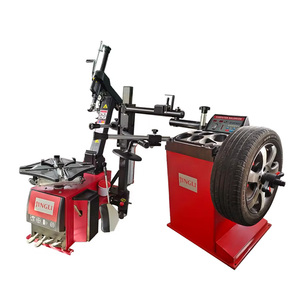
All categories
Featured selections
Trade Assurance
Buyer Central
Help Center
Get the app
Become a supplier

(3155 products available)













































 Ready to Ship
Ready to ShipA manual tyre changer is a piece of equipment used to change tires. It provides a stable platform for mounting and dismounting tires. Several types of manual tire changers are available:
Manual tire changer with base plate
This tire changer has a base plate that is positioned on the ground. The base plate is wider to provide more stability and support. It also has a large lever arm that is used to break the tire bead and lift the tire. The manual tire changer with a base plate is ideal for changing larger tires, such as truck and 4X4 tires.
Portable manual tire changer
A portable manual tire changer is lightweight and compact. It is designed to be used at roadside emergencies or tire shops. Despite being portable, it has all the basic functions required to change a tire. The portable manual tire changer has an easy bead-breaking mechanism and a tire lever.
Heavy-duty manual tire changer
The heavy-duty manual tire changer is designed for changing large and tough tires. This tire-changing equipment has a robust construction with reinforced materials. The changer also has a powerful bead-breaking mechanism. Some of the bead-breaking mechanisms are hydraulic or pneumatic. The heavy-duty manual tire changers are commonly used in industries and commercial workshops.
Motorcycle manual tire changer
The motorcycle manual tire changer is designed for changing small tires. This is because it is specifically designed and adjusted to handle the smaller diameter and width of motorcycle tires. The tire changer has gentle tire irons and bead tools that minimize the risk of damaging the tire or wheel. The motorcycle manual tire changer is also used in shops that specialize in changing and repairing motorcycle tires.
Manual tyre changers come with different specifications, which influence their efficiency and performance.
Clamping range
The clamping range is the maximum and minimum diameter that can be held on the turntable. It is important because it determines the sizes of the wheels that can be changed. The clamping range is usually between 10 to 30 inches.
Changing tyre size
This is the largest and smallest tyre dimensions that the machine can work on. Manual changers can work on tyres with a maximum diameter of 1000mm and a minimum of 400mm.
Pressure
Pressure is important in the manual tyre changer machine because it generates the force required to change the tyre. The pressure is usually between 6 to 8 bars.
Max wheel width
Wheel width is also a specification in a manual tyre changer. It limits the size of the wheel that can be changed. Manual tyre changers have a maximum wheel width of 300mm.
Max wheel diameter
The maximum diameter of the wheel that can be accommodated by a manual tyre changer is 1020mm. This specification is important, especially when changing oversized wheels.
Bead breaker force
The bead breaker force is one of the key components of a manual tyre changer. It generates the force needed to break the tyre bead during the tyre-changing process. The force is generally between 200 to 600 kg.
Maintaining a manual tyre changer is very important to ensure its efficiency and performance. The following are some of the maintenance requirements:
There are so many factors to consider when buying a manual tyre changer, such as the budget, the number of employees, and the company’s future growth plans. Here are more factors to help business buyers make an informed decision:
Workforce Capability
Consider the manual tyre-fitting staff's skill level. A highly skilled and experienced team may handle more complex tools and equipment. In contrast, a less experienced team may require more straightforward, user-friendly solutions.
Future Growth and Scalability
Think about the company's future growth plans. If expansion is anticipated, investing in more advanced, efficient tools and equipment can accommodate increased workload and productivity as the business grows.
Budget
The initial cost of a manual tyre changer is vital, but so is its long-term value. Some changers might have a higher upfront cost but offer more efficiency or durability, saving money over time.
Consider not only the purchase price but also potential maintenance costs, repairs, and required additional tools or equipment. Also, look at the manual tyre changer price and ensure it aligns with the set budget.
Business Type
For instance, a roadside assistance business might prioritize portability and quick setups, while a garage specializing in high-performance vehicles might focus on changers that handle larger and more delicate tires.
Safety Considerations
Tyre changers can be dangerous if not handled properly. Consider tools with safety features, such as guards, emergency stops, and ergonomic designs to reduce the risk of injury. Additionally, think about the training requirements and safety protocols for using manual tyre changers.
Space and Storage
Consider the available workspace and storage for the manual tyre changer and related tools. Some changers can be folded or have a compact design for easy storage, which is beneficial if space is limited.
Flexibility and Versatility
Some manual tyre changers are designed to be versatile and handle different tyre sizes and types. This flexibility can be beneficial if the business deals with various vehicles and tyre specifications. Consider whether investing in a changer with multiple capabilities suits the business needs and customer base.
Warranty and Support
Check the warranty offered by the manual tyre changer supplier. A good warranty can protect the investment and cover unforeseen defects or problems. Additionally, consider the support level, such as technical assistance or spare parts availability.
Some tyre-changing tools can be dangerous if not used correctly. Follow the instructions carefully and pay attention to safety warnings. Here are the steps to change a manual tyre:
Q1: How long does it take to change a tire with a manual tire changer?
A1: With a manual tire changer, the time taken to change a tire can vary depending on the operator's skill level, the type of tire, and the wheel size. However, on average, it can take anywhere from 15 to 30 minutes to complete a tire change manually.
Q2: Is training required to use a manual tire changer properly?
A2: While training is not always mandatory, it is highly recommended. Proper training ensures that the manual tire changer is used safely and effectively, reducing the risk of injury and tire damage.
Q3: Can anyone use a manual tire changer, or is it only for professionals?
A3: Anyone can use a manual tire changer, but it is primarily designed for individuals with basic mechanical skills or professional mechanics. Some knowledge of tire-changing techniques and safety precautions is beneficial.
Q4: What are the safety considerations when using a manual tire changer?
A4: Some key safety considerations when using a manual tire changer include: 1. Ensuring the machine is securely anchored to prevent tipping. 2. Wearing appropriate personal protective equipment (PPE), such as gloves and safety glasses. 3. Following the manufacturer's instructions and operating guidelines.
Q5: Can a manual tire changer be used for all types of tires?
A5: Manual tire changers are generally suitable for most common types of tires, including passenger car and light truck tires. However, some specialized or oversized tires may require additional equipment or adapters.